Research - (2021) Volume 9, Issue 2
Evaluation of Attitude towards Choosing Medical and Dental Sciences as a Profession after Coronavirus Pandemic
Tahoora Taskeen L1, Hannah R1* and Lavanya Prathap2
*Correspondence: Hannah R, Departments of Oral and maxillofacial Pathology, Saveetha Dental College and Hospitals, Saveetha Institute of Medical and Technical Sciences (SIMATS), Saveetha University Tamilnadu, India, Email:
Abstract
Coronavirus disease (COVID-19) has become a pandemic throughout the world. Health professionals are struggling to bring the situation under control. Among health professionals struggling to overcome the pandemic, there is an increased anxiety level The global crisis has caused much anxiety and depression among people which would take decades for people to come out of. Hence the current study aims to analyze the attitude of students in choosing medical and dental sciences as a profession after Coronavirus pandemic. A cross sectional survey was conducted using a self-administered standardized questionnaire. The questionnaire was distributed through an online portal (Google Forms) and the study population included 200 individuals of age’s 15-19 years. The data was collected and analyzed using SPSS software. Based on the result of the study 74.75% of students were passionate towards the medical and health science field. 69.31% of students had responded that covid-19 pandemic had impacted their passion. 57.4% of students responded that pandemic had brought anxiety among parents and students to choose medical and health science courses and only 5.9% denied it. 98% responded that even after choosing the medical field as a profession there will be constant stress in the future. Within the limitations of the study we conclude that Covid 19 is a stumbling block for the students of the 15-19 age groups from choosing medical sciences as a profession. This can be attributed to the anxiety and fear surrounding the pandemic.
Keywords
Medical and health science course, Coronavirus, Pandemic, COVID-19, Medical profession, Anxiety
Introduction
Coronavirus Disease 2019 (COVID-19) is caused by severe acute respiratory syndrome Coronavirus 2 (SARS-COV-2) which was first identified in Wuhan, China. Specific genes were found in Coronavirus which had glycoprotein spikes which acts as a link to approach the host. Health care professionals and students insisted for more health programs on awareness on preventive measures of COVID-19. From 30th March 2020 up to date, 693,224 cases in 204 countries have been diagnosed. COVID-19 has caused a disastrous effect throughout the world. Coronavirus disease (COVID-19) has become an unstoppable pandemic throughout the world. Health professionals are struggling to overcome this conflict by putting their lives under threat day in and day out. As they are struggling to overcome the pandemic there is increased anxiety level among health professionals [1,2].
Anxiety among health professionals creates a fear among the upcoming generation in choosing medical and health sciences as their profession. As we know that even after the COVID-19 pandemic health professionals are at greater risk [2]. It had become mandatory for every health professional to use personal protection equipment [2].
As per a recent study done by Mrudula et al. it reports that 96% of health workers have undergone psychological trauma. The pandemic had brought a disastrous impact on medical practices [3]. The impact on medical practice would definitely affect the next generation of doctors which will demolish the passion of medicine among upcoming doctors [4]. Another study done states that there is an increased negative attitude of health workers towards COVID-19 [5]. The global crisis has caused much anxiety and depression among people which would take decades to come out of pandemic. The aim of the study was to analyse the attitude of school students towards choosing medical and dental sciences as a profession after Coronavirus pandemic.
Materials and Methods
A cross sectional survey study was done among 200, 15-19 year old school students. The study was approved by the institutional scientific review board. Self-administered standardized questionnaires including 15 questions were designed based on knowledge, attitude and practice towards choosing medical and dental sciences as a profession after COVID-19 pandemic. The validation of the questionnaire was done. The questionnaire was then distributed through an online Google Forms link. The participants were explained about the purpose of the study in detail. The questions were carefully studied and the corresponding answers were marked by the participants. The data was collected and analysed using chi square in SPSS to analyze the significance.
Results and Discussion
In the current study, 30.20% of 17 age group people had responded whereas 29.2% of 15 and 16 age group respondents have taken part in the survey, 9.9% of 18 age group people and1.49% of 19 age group participants has taken part in the survey (Figure 1).
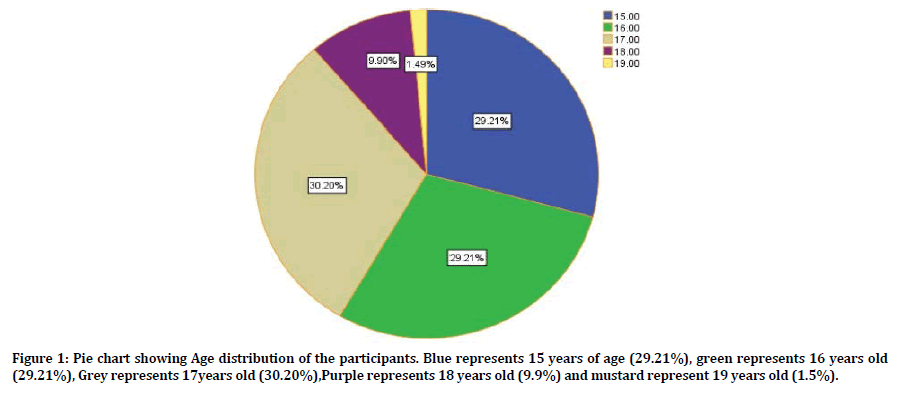
Figure 1. Pie chart showing Age distribution of the participants. Blue represents 15 years of age (29.21%), green represents 16 years old (29.21%), Grey represents 17years old (30.20%),Purple represents 18 years old (9.9%) and mustard represent 19 years old (1.5%).
On assessing the knowledge of the students, 60.4% of students responded that medical professionals are mostly affected due to COVID-19 and only 1% and 5% responded that pharmaceuticals and allied health sciences are mostly affected respectively (Figure 2). 65.3% of students were scared to choose medicine as their profession due to the Pandemic and 0.5% was scared to choose allied health sciences (Figure 3). 98% of students given affirmative responses for the medical field will be at constant stress in future because of the pandemic, on comparing the responses with the age group in Chisquare we found statistical significance showing P value as 0.04 (Figures 4 and 5). 45.5% had responded homemaker as the safe profession after the pandemic and 27.2% responded architecture as the safe profession after the pandemic (Figure 6). The responses for the safe profession after the pandemic was compared with the age group which was evaluated in Chi square and found to have statistical significance with P value 0.01 (Figure 7).
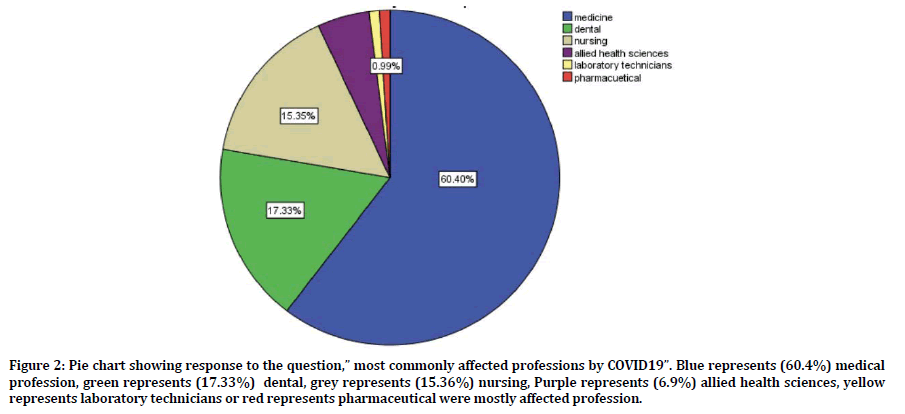
Figure 2. Pie chart showing response to the question,” most commonly affected professions by COVID19”. Blue represents (60.4%) medical profession, green represents (17.33%) dental, grey represents (15.36%) nursing, Purple represents (6.9%) allied health sciences, yellow represents laboratory technicians or red represents pharmaceutical were mostly affected profession.
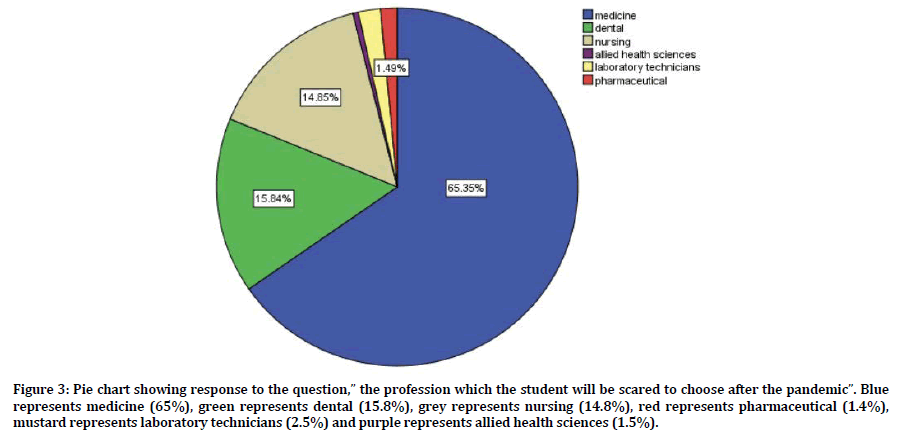
Figure 3. Pie chart showing response to the question,” the profession which the student will be scared to choose after the pandemic”. Blue represents medicine (65%), green represents dental (15.8%), grey represents nursing (14.8%), red represents pharmaceutical (1.4%), mustard represents laboratory technicians (2.5%) and purple represents allied health sciences (1.5%).
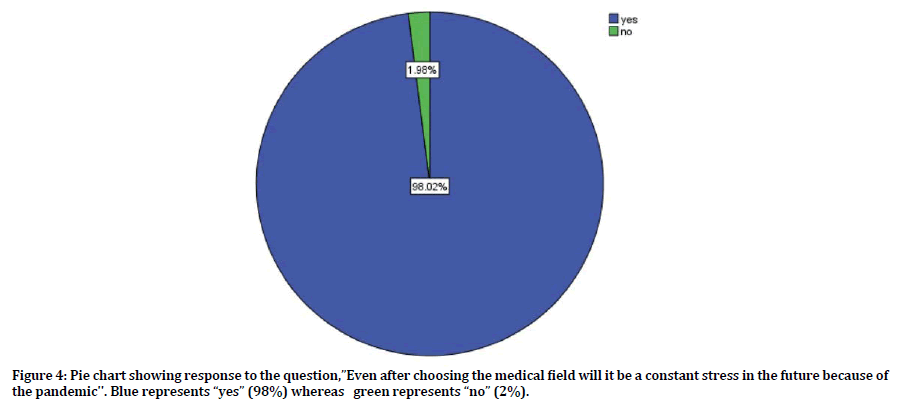
Figure 4. Pie chart showing response to the question,”Even after choosing the medical field will it be a constant stress in the future because of the pandemic''. Blue represents “yes” (98%) whereas green represents “no” (2%).
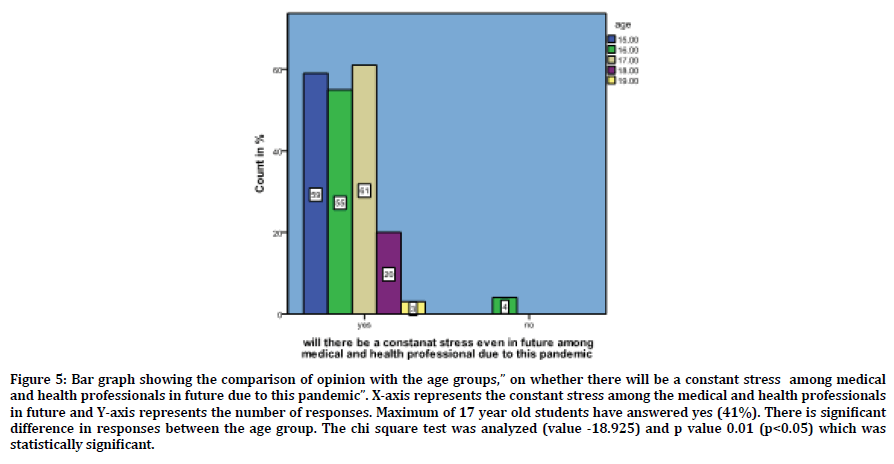
Figure 5. Bar graph showing the comparison of opinion with the age groups,” on whether there will be a constant stress among medical and health professionals in future due to this pandemic”. X-axis represents the constant stress among the medical and health professionals in future and Y-axis represents the number of responses. Maximum of 17 year old students have answered yes (41%). There is significant difference in responses between the age group. The chi square test was analyzed (value -18.925) and p value 0.01 (p<0.05) which was statistically significant.
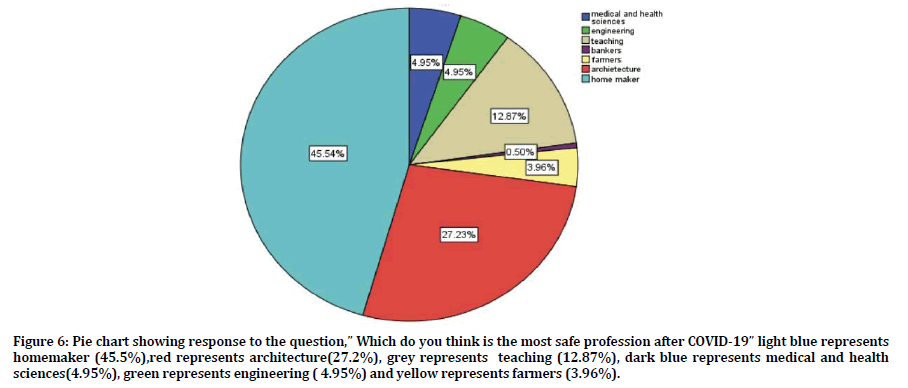
Figure 6. Pie chart showing response to the question,” Which do you think is the most safe profession after COVID-19” light blue represents homemaker (45.5%),red represents architecture(27.2%), grey represents teaching (12.87%), dark blue represents medical and health sciences(4.95%), green represents engineering ( 4.95%) and yellow represents farmers (3.96%).
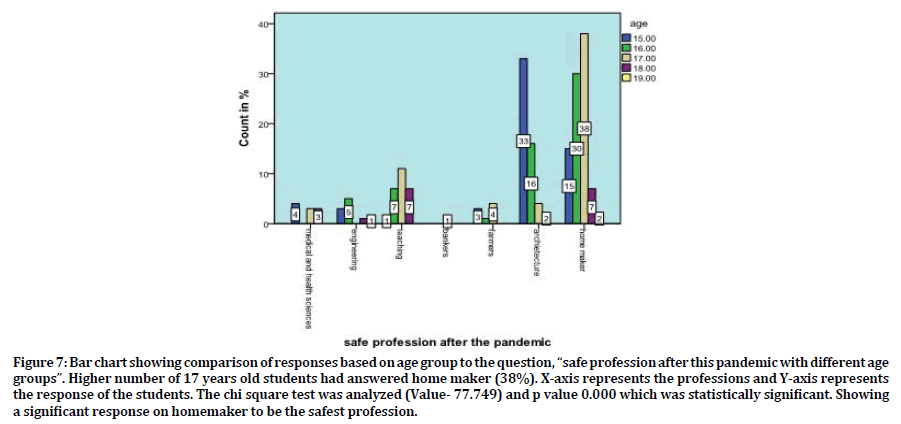
Figure 7. Bar chart showing comparison of responses based on age group to the question, “safe profession after this pandemic with different age groups”. Higher number of 17 years old students had answered home maker (38%). X-axis represents the professions and Y-axis represents the response of the students. The chi square test was analyzed (Value- 77.749) and p value 0.000 which was statistically significant. Showing a significant response on homemaker to be the safest profession.
When the attitude of the students was analysed, 68.23% of science students had taken part in the survey (Figure 8). 72.8% of students had planned to do medical or health science in upcoming years (Figure 9). 74.75% of students were passionate towards the medical and health science field (Figure 10). 69.31% of students had responded that covid-19 pandemic had impacted their passion (Figure 11). 92.08% of respondents reported that parents are afraid of joining their children in medical and health science courses (Figure 12).
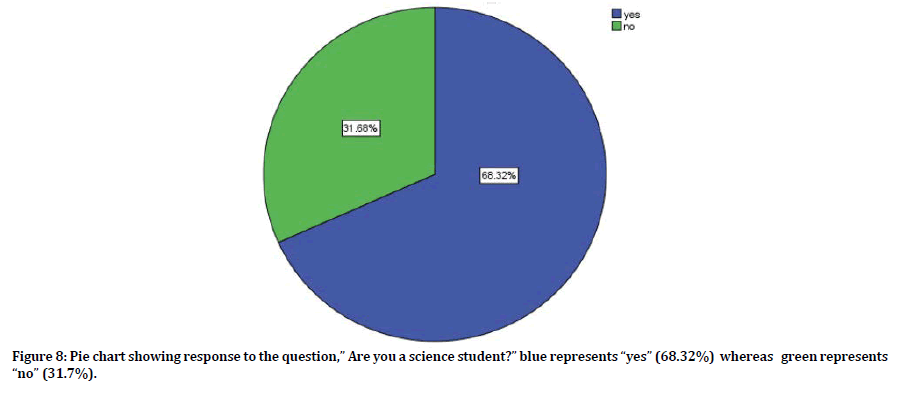
Figure 8. Pie chart showing response to the question,” Are you a science student?” blue represents “yes” (68.32%) whereas green represents “no” (31.7%).
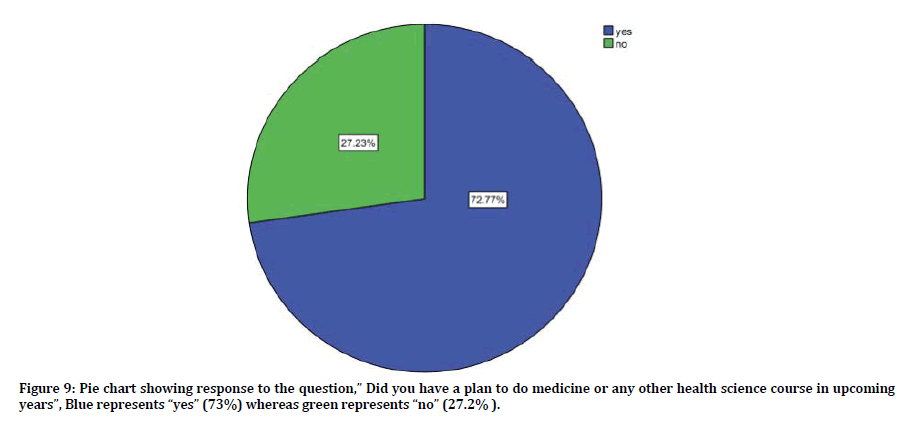
Figure 9. Pie chart showing response to the question,” Did you have a plan to do medicine or any other health science course in upcoming years”, Blue represents “yes” (73%) whereas green represents “no” (27.2% ).
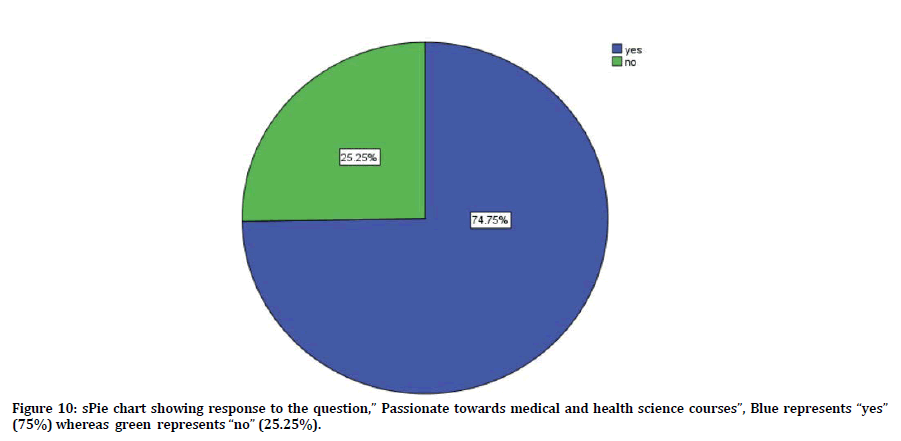
Figure 10. Pie chart showing response to the question,” Passionate towards medical and health science courses”, Blue represents “yes” (75%) whereas green represents “no” (25.25%).
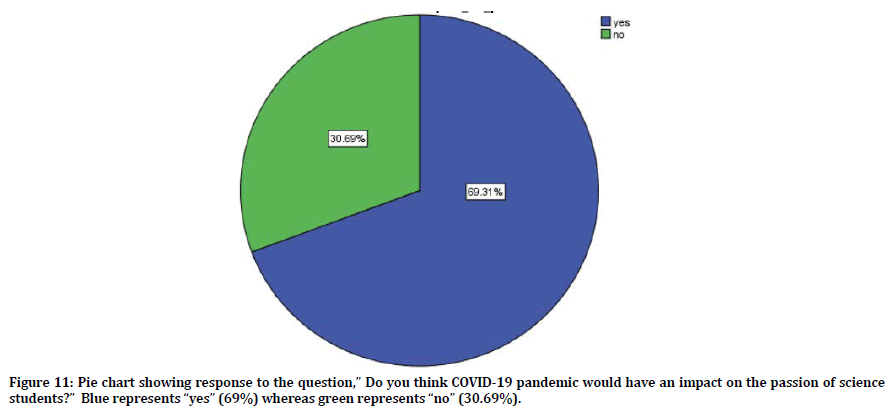
Figure 11. Pie chart showing response to the question,” Do you think COVID-19 pandemic would have an impact on the passion of science students?” Blue represents “yes” (69%) whereas green represents “no” (30.69%).
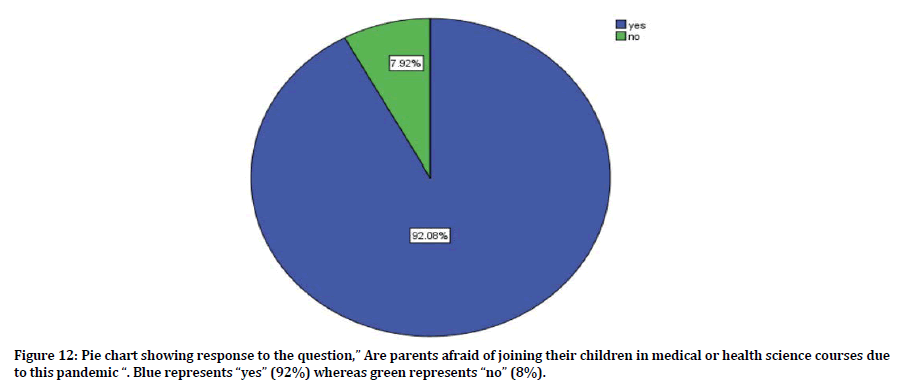
Figure 12. Pie chart showing response to the question,” Are parents afraid of joining their children in medical or health science courses due to this pandemic “. Blue represents “yes” (92%) whereas green represents “no” (8%).
88.6% of participants responded that demand for health sciences and medical courses may increase in upcoming years (Figure 13). When the responses were compared between the age group in chi square statistical significance was analyzed with P value 0.01 (Figure 14). 57.4% of students responded that pandemic had brought anxiety among parents and students to choose medical and health science course whereas 5.9% denied and 28.2% of participants responded that probability of anxiety among parents and students is more (Figure 15). 97%of participants admitted that life of health professionals is at high risk because of the COVID-19 pandemic (Figure 16). 59.4% of students responded that the pandemic had demolished the passion towards medical and health science field (Figure 17). 94.1% of students responded that there will be decreased takers for medical and health science courses in the year 2020 (Figure 18). On comparing the responses for decreased takers for medical and health science courses in the year 2020 between the age group statistical significance was found P value 0.01 (Figure 19).
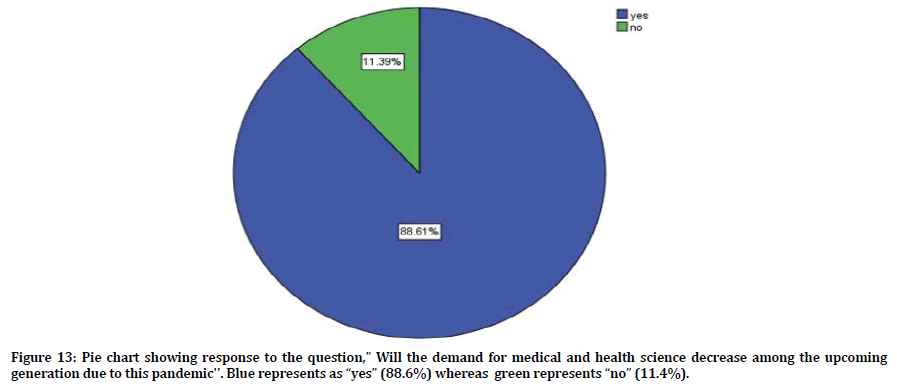
Figure 13. Pie chart showing response to the question,” Will the demand for medical and health science decrease among the upcoming generation due to this pandemic''. Blue represents as “yes” (88.6%) whereas green represents “no” (11.4%).
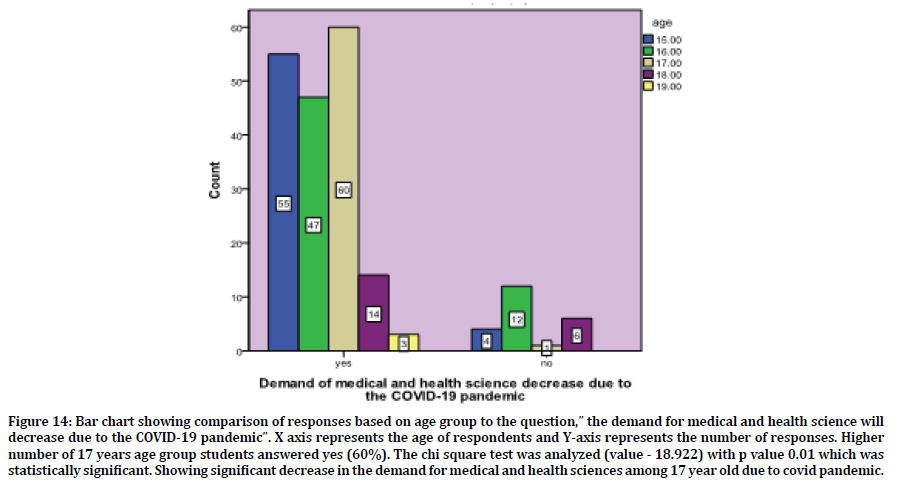
Figure 14. Bar chart showing comparison of responses based on age group to the question,” the demand for medical and health science will decrease due to the COVID-19 pandemic”. X axis represents the age of respondents and Y-axis represents the number of responses. Higher number of 17 years age group students answered yes (60%). The chi square test was analyzed (value - 18.922) with p value 0.01 which was statistically significant. Showing significant decrease in the demand for medical and health sciences among 17 year old due to covid pandemic.
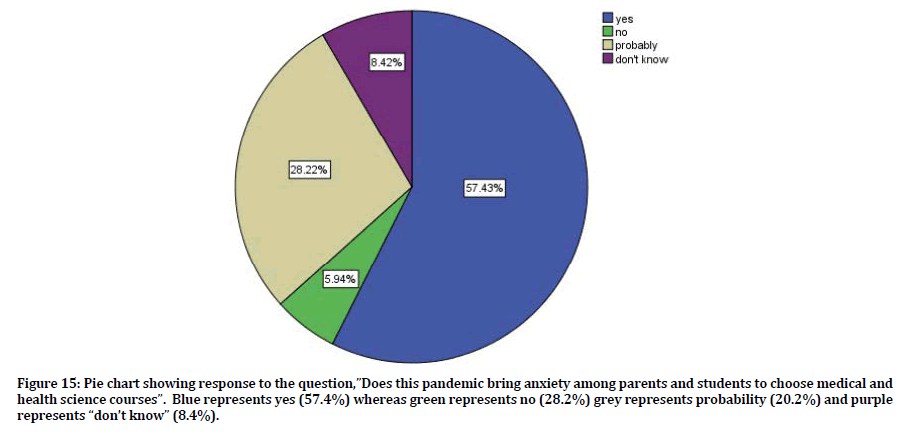
Figure 15. Pie chart showing response to the question,”Does this pandemic bring anxiety among parents and students to choose medical and health science courses”. Blue represents yes (57.4%) whereas green represents no (28.2%) grey represents probability (20.2%) and purple represents “don’t know” (8.4%).
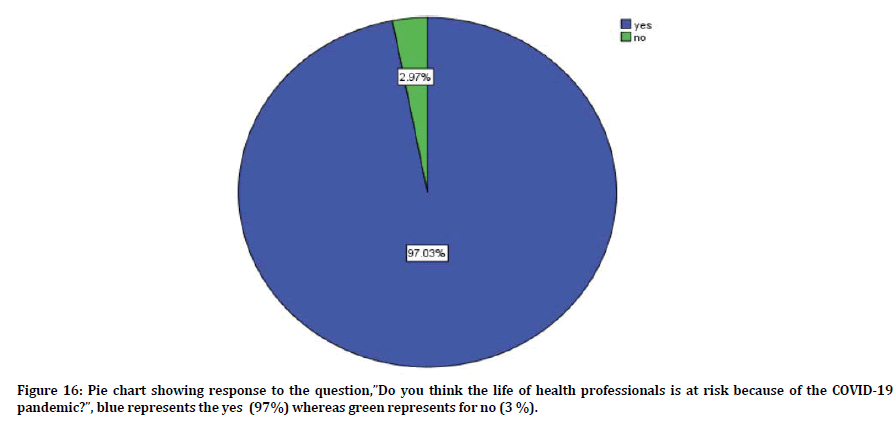
Figure 16. Pie chart showing response to the question,”Do you think the life of health professionals is at risk because of the COVID-19 pandemic?”, blue represents the yes (97%) whereas green represents for no (3 %).
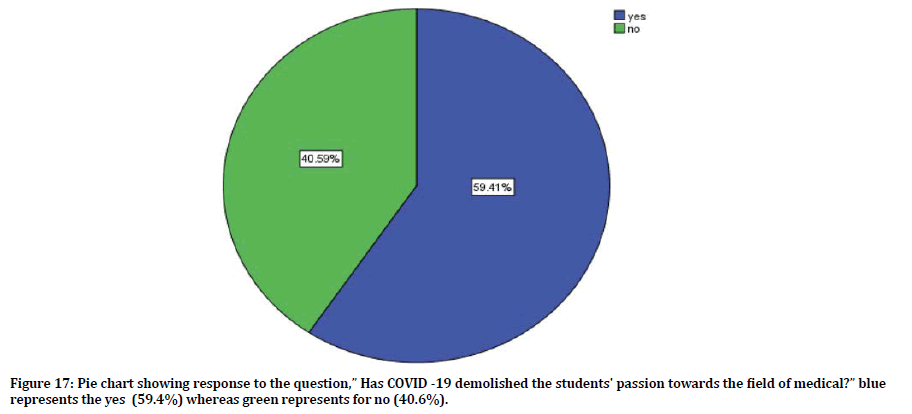
Figure 17. Pie chart showing response to the question,” Has COVID -19 demolished the students' passion towards the field of medical?” blue represents the yes (59.4%) whereas green represents for no (40.6%).
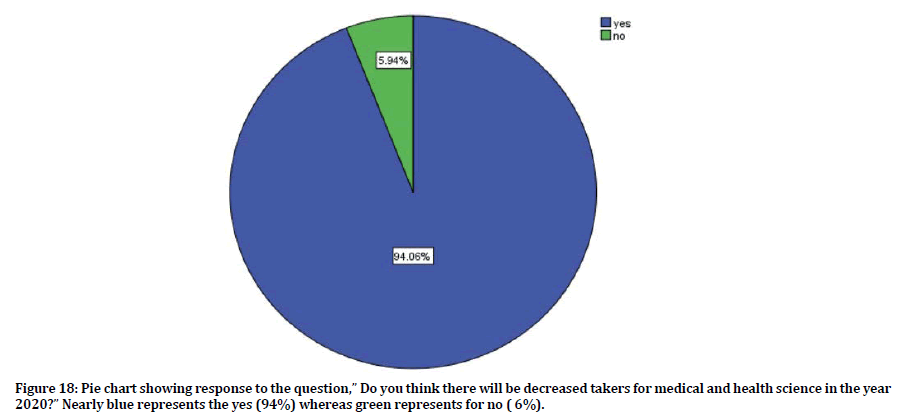
Figure 18. Pie chart showing response to the question,” Do you think there will be decreased takers for medical and health science in the year 2020?” Nearly blue represents the yes (94%) whereas green represents for no (6%).
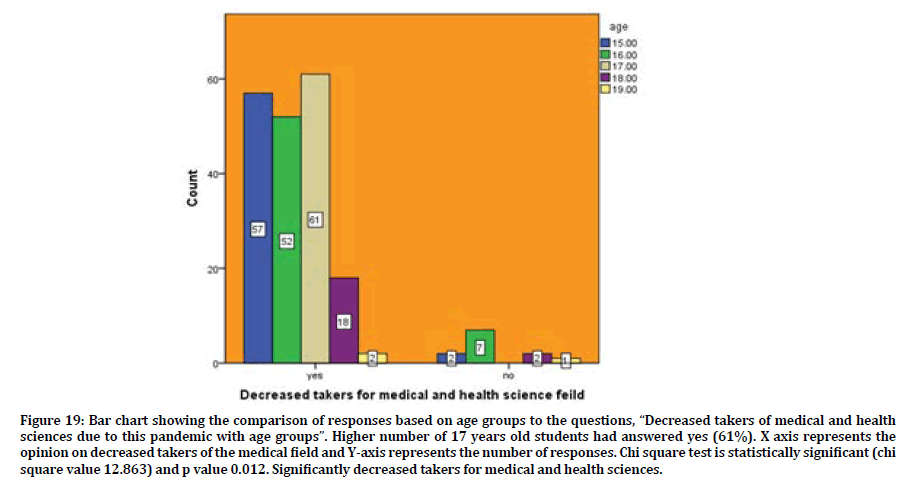
Figure 19. Bar chart showing the comparison of responses based on age groups to the questions, “Decreased takers of medical and health sciences due to this pandemic with age groups”. Higher number of 17 years old students had answered yes (61%). X axis represents the opinion on decreased takers of the medical field and Y-axis represents the number of responses. Chi square test is statistically significant (chi square value 12.863) and p value 0.012. Significantly decreased takers for medical and health sciences.
In the current study 98% responded that after choosing the medical field as a profession there will be constant stress in the future due to COVID-19 pandemic. In a similar way, the study done by Mrudula O et al. in 2020 had reported that 71.5% of professionals were depressed due to the COVID-19 pandemic [2], difference in percentage of response may be due to difference in population [2]. In the current study 60.4% of students responded that medical professionals are mostly affected due to COVID-19 whereas in the study done by Kharder et al. in 2020 only 24.6% were worried that medical professionals were more affected [6].
82.3% of participants showed a positive attitude towards COVID-19 in the study done by Geetha et al. but in the current study the anxiety level or the negative attitude towards COVID-19 was about 92% [7]. In the current study 65.3% respondents were scared to choose medicine whereas in the study done by Mrudula et al. they had reported that 50.4% medical professionals are depressed due to COVID-19 impact.
In the current study, 69.31% gave an affirmative response for the impact of COVID-19 on passion and 92.08% responded that parents are afraid to join their children in medical and health science course similarly in the study done by Deblina et al. 75.1% participants were anxious of COVID-19 [2]. In the current study 57.43% of parents and students are anxious of choosing medical and health science field as a profession whereas in the study done by Xu P et al in 2020 reported that female students were more anxious about COVID-19 [8].
In the current study 97% responded that health professionals' life is at high risk due to the pandemic whereas in the study done by Abdullah et al reported that 61.2% of professionals had psychological trauma with suspicion that they are prone to COVID-19 [9]. The other survey declares that increased amount of psychological trauma is perceived among others due to this pandemic [10]. In previous literature done by Palati et al. Guru et al. Uma et al. Hannah et al. Ahad et al. Manohar et al. and Ahmed Hilal et al. conducted a survey based on knowledge, attitude and practice among the target population similar to the current study.
Various studies had been done to find an early diagnosis for certain diseases and certain studies had tried to find a treatment by correlating saliva or any other organic matter of the body as per the current study the students who are assumed to be the future doctors of the county are anxious to medical and health science course due to the pandemic but this will never help the country to find solutions for newly existing diseases [11-25].
The limitations of the study were small sample size about 200 and lack of quantitative data and homogeneous population. Future scope of the study would be that in the modern world risk of pandemic are increasing hence the future citizens are responsible to find out a cure and treatment and evolutionary diseases. They being anxious about COVID-19 pandemic will be a stressful situation for the world as there may be decreased takers for medical and health science courses in future. In future there may be more of newly evolving diseases without a cure due to fewer doctors to discover the remedy.
Conclusion
The results of the study has shown that there is increased anxiety among the 15-19 age group school students to choose medical and health science courses in the background of COVID 19 pandemic. Awareness needs to be created among the students and parents regarding the various preventive measures employed in order to protect the health care workers. They should also be encouraged to follow their dream in pursuing health sciences and not allow COVID19 be a stumbling block.
References
- Roy D, Tripathy S, Kar SK, et al. Study of knowledge, attitude, anxiety & perceived mental healthcare need in Indian population during COVID-19 pandemic. Asia J Psychiatr 2020; 51:102083.
- Mrudula O. Impact of corona virus– A statistical evaluation. J Adv Res Dynamical Control Systems 2020; 12:399–407.
- Cavallo JJ, Forman HP. The economic impact of the COVID-19 pandemic on radiology practices. Radiology 2020; 201495.
- Allen J. My future in medicine: How COVID-19 is inspiring the next generation of infectious disease specialists. J Infectious Diseases 2020; 221:1938-1939.
- Chen Y, Yu Q, Farraye FA, et al. Patterns of endoscopy during COVID-19 pandemic: A global survey of interventional inflammatory bowel disease practice. Intest Res 2020; 2.
- Khadar Y, Al Nsour M, Al-Batayneh OB, et al. Dentists’ awareness, perception, and attitude regarding COVID-19 and infection control: Cross-sectional study among jordanian dentists. JMIR Public Health 2020; 6:e18798.
- Geetha M, Seshadri LN. COVID-19: A “Violent” pandemic for health care workers in India. COVID-19 Special Issue 2020; 32–40.
- Xu P, Sun GOD, Li ZZ. Clinical characteristics of two human-to-human transmitted coronaviruses: coronavirus Disease 2019 vs. middle eastern respiratory syndrome coronavirus. Eur Rev Med Pharmacol Sci 2020; 24:5797–809.
- Abdullah A, Faisal S, Jan H, et al. A perspective study on oral-fecal transmission of COVID-19, its prevention and management. Int Cardiovascular Forum J 2020; 20.
- Garbe J, Eisenmann S, Heidemann CS, et al. Are German endoscopy units prepared for the COVID-19 pandemic? A nationwide survey. Med Rxiv 2020.
- Palati S, Ramani P, Sherlyn H, et al. Knowledge, attitude and practice survey on the perspective of oral lesions and dental health in geriatric patients residing in old age homes Indian J Dent Res 2020; 31.
- Shree KH, Ramani P, Sherlin H, et al. Saliva as a diagnostic tool in oral squamous cell carcinoma–a systematic review with Meta analysis. Pathol Oncol Res 2019; 25:447-453.
- Prasanna GE, Gheena S. A study of empathy across students from 4 health disciplines among 1st years and Final years. Res J Pharm Technol 2016; 9:1472.
- Abitha T, Santhanam A. Correlation between zygomatic and maxillary central incisor width for gender identification. Br Dent Sci 2019; 22:458–466.
- Uma PK, Ramani P, Sherlin HJ, et al. Knowledge about legal aspects of medical negligence in india among dentists--A questionnaire survey. Medico Legal Update 2020; 20:111–115.
- Krishnan RP, Ramani P, Sherlin HJ, et al. Surgical specimen handover from operation theater to laboratory: A survey. Ann Maxillofac Surg 2018; 8:234–238.
- Jayaraj G, Santhanam A. Age estimation of an individual using olze’s method in Indian population-A cross-sectional study. Prof. RK Sharma 2019; 13:121.
- Hannah R, Ramani P, Sherlin HJ, et al. Awareness about the use, ethics and scope of dental photography among undergraduate dental students dentist behind the lens. Res J Pharm Technol 2018; 11:1012-1016.
- Gunasekaran G, Abilasha R. Tooth sensitivity among residential University students In Chennai. Asian J Pharm Clin Rese 2016; 63.
- Sarbeen JI, Gheena S. Microbial variation in climatic change and its effect on human health. Res J Pharm Technol 2016; 9:1777.
- Santhanam A. Determination of physical height using clinical crown height of deciduous teeth. Indian J Forensic Med Toxicol 2019; 13.
- Ahad M, Gheena S. Awareness, attitude and knowledge about evidence based dentistry among the dental practitioner in Chennai city. Res J Pharm Technol 2016; 9:1863.
- Sukumaran G, Padavala S. Molar incisor hypomineralization and its prevalence. Contemporary Clin Dent 2018; 9:246.
- Manohar J. Abhilasha R. A study on the knowledge of causes and prevalance of pigmentation of gingiva among dental students. Indian J Public Health Res Develop 2019; 10:95.
- Sheriff KAH, Ahmed Hilal Sheriff K, Santhanam A. Knowledge and awareness towards oral biopsy among students of saveetha dental college. Res J Pharm Technol 2018; 11:543.
Author Info
Tahoora Taskeen L1, Hannah R1* and Lavanya Prathap2
1Departments of Oral and maxillofacial Pathology, Saveetha Dental College and Hospitals, Saveetha Institute of Medical and Technical Sciences (SIMATS), Saveetha University Tamilnadu, India2Departments of Anatomy, Saveetha Dental College and Hospitals, Saveetha Institute of Medical and Technical Sciences (SIMATS), Saveetha University Tamilnadu, India
Citation: Tahoora Taskeen L, Hannah R, Lavanya Prathap, Evaluation of Attitude towards Choosing Medical and Dental Sciences as a Profession after Coronavirus Pandemic, J Res Med Dent Sci, 2021, 9 (2):383-392.
Received: 27-Sep-2020 Accepted: 22-Feb-2021
